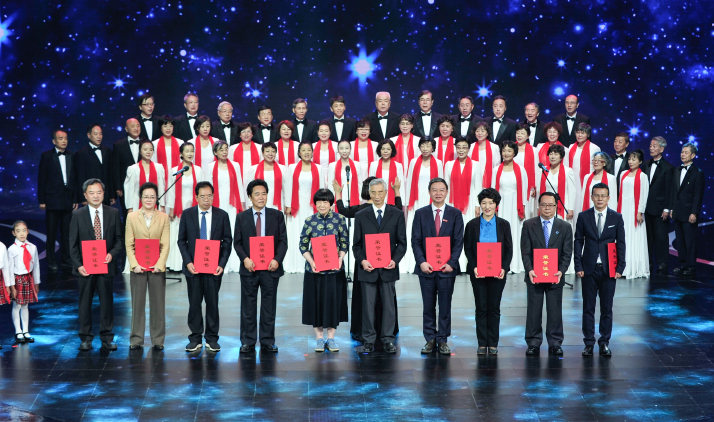| Latest News |
| Scientists develop animal models to assess countermeasures against emerging viruses | |
| Among all teams on the frontline of fighting COVID-19, Qin Chuan and her team remain relatively unknown to the public | |
|
|
 Qin Chuan (second left, front) is honored as an outstanding sci-tech professional in Beijing on June 10, 2018 (XINHUA)
Seventeen years ago, when China suffered an outbreak of severe acute respiratory syndrome (SARS), it took seven months to develop animal models essential for the application of anti-virus drug findings from bench to bedside. "At that time, we analyzed more than 20 animal species and finally identified the rhesus monkey model as the best match to assess vaccine effectiveness," Qin Chuan, a researcher and head of the Institute of Laboratory Animal Sciences under the Chinese Academy of Medical Sciences, recalled. In February 2020, the World Health Organization assembled an international panel to develop animal models for COVID-19 to accelerate the testing of vaccines and therapeutic agents in the global battle against the epidemic. At the meeting, Chinese scientists announced they had already established mouse and monkey models for COVID-19 research, shedding light on the possible treatments and vaccine development. The research team is once again headed by Qin. At the age of 62, she has now been engaged in experimental pathology for more than three decades. Their combined efforts eventually paid off. On May 6, 2020, one of China's vaccine candidates proved effective in protecting monkeys from the novel coronavirus, according to the world's first report on animal trial results for COVID-19 vaccine candidates released in academic journal Science. Successful trials The humanized transgenic mouse models were developed by January 29, 2020, seven days after Qin and her team had been assigned the task, which was quickly followed by the creation of rhesus monkey models on February 14. Liu Jiangning, deputy head of the institute, said it is an international general practice to test the effectiveness and safety of any drug or vaccine on animals before its application in human clinical trials. Animal models are the lab equivalent of human patients. They are used to study how exactly the patient is infected, how the immune system fights back, how the disease occurs and spreads, and whether the administered vaccines or drugs work. According to the report jointly authored by Qin's team and experts from Beijing-based Sinovac Biotech, animal trials showed that the purified inactivated COVID-19 vaccine candidate they developed was able to induce coronavirus neutralizing antibodies in mice, rats and non-human primates. These antibodies neutralized 10 representative coronavirus strains, indicating a possible broader neutralizing ability against the virus strains circulating worldwide. Two different doses of the vaccine subsequently were administered to eight rhesus monkeys. Three weeks later, the group introduced the novel coronavirus into the monkeys' lungs, and none developed a full-blown infection. Analysis suggested that the vaccine was safe, and the data supported the rapid clinical development of vaccines for human. "The standards and methods we proposed during that panel meeting have also been adopted by scientists from other countries," Liu said. Most animal trials of the COVID-19 vaccines developed by China were conducted in Qin's laboratory. "Many foreign developers have reached out to us," Qin said. Their findings have been included into the diagnosis and treatment protocol for COVID-19 patients by the National Health Commission, which provides a scientific basis for the prevention and control of the epidemic. To enable more scientists to gain access to animal models as soon as possible, the institute collaborated with a number of enterprises to breed mice with the latest technology.
A man fills a form before receiving a jab of COVID-19 vaccine at a vaccination site in Beijing on February 20 (XINHUA) Keeping the faith Back in 2003, China lacked self-developed technologies and thus relied on imports for both equipment and animal models. This delayed the prevention and control of infectious diseases such as SARS. "The experience in combating SARS reminded us of the urgent need to address this problem," Qin said. Qin became determined to promote China's laboratory animal sciences. Under her watchful gaze, the research team, over the course of 17 years, has built up what is now the largest resource of animal models for human disease research in China, as well as facilities for comparative medical analysis. Researchers of animal models must wear heavy protective suits when working inside the P3 laboratory designed to study agents that may produce potentially lethal diseases. In addition to viruses, they also face attacks from the animals used in the trials. Laboratory spaces are pressure-controlled, and some face radiation hazards or biohazard. Among all teams on the frontline of fighting COVID-19, Qin and her team remain relatively unknown to the public though everyone worked three shifts and rarely got a day off. They are unsung heroes in the field of laboratory animal sciences, said Xu Nanping, Vice Minister of Science and Technology. "All we thought about was to find more solutions and save more lives. As scientists, this is both our job and our responsibility," Qin said. (Print Edition Title: Behind the Scenes of Viral Science) Copyedited by Elsbeth van Paridon Comments to mamm@bjreview.com |
|
||||||||||||||||||||||||||||
|
